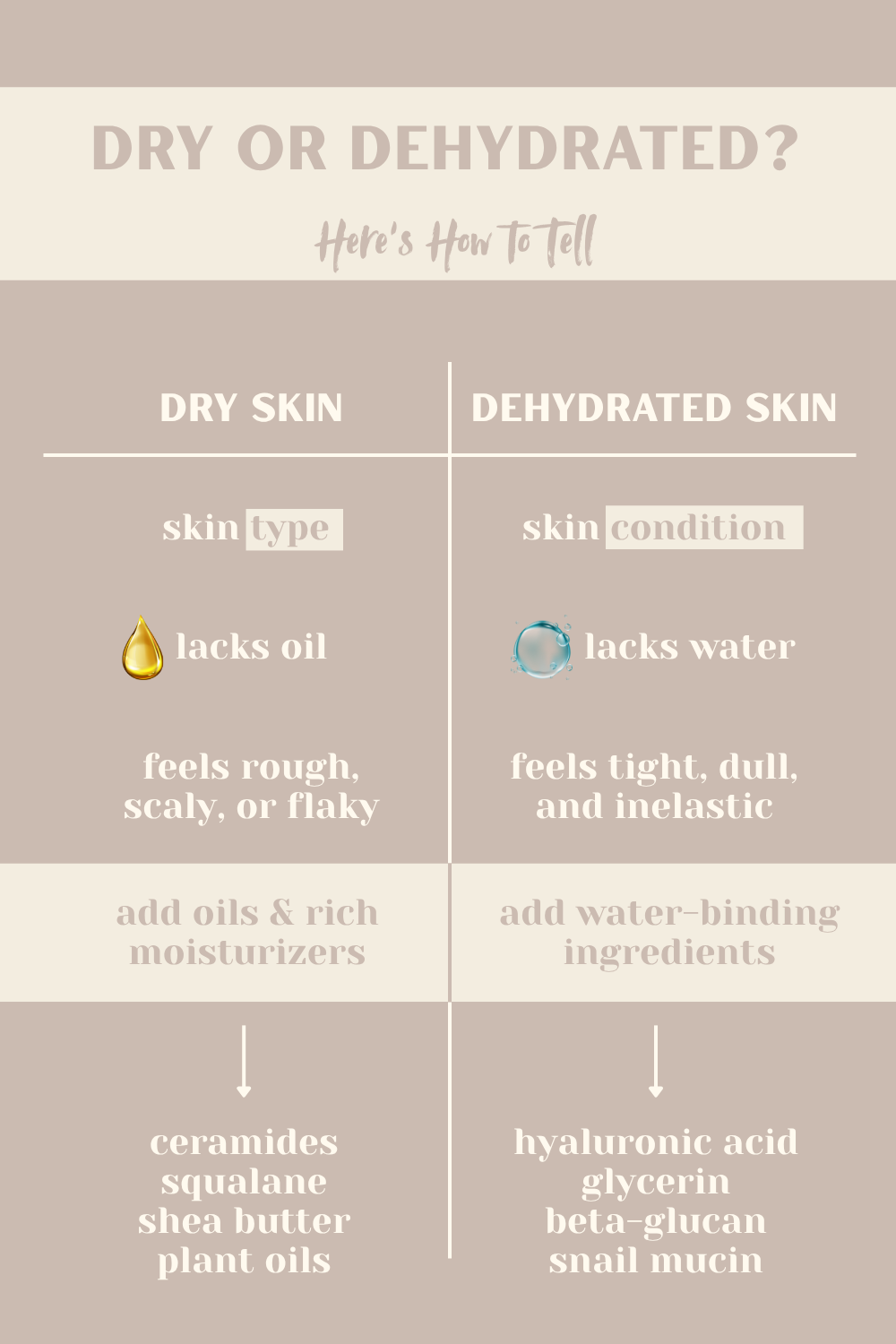Say Goodbye to Dehydrated Skin: 5 Steps to Restore Hydration

Ever have one of those days where you slather on moisturizer, yet your face still feels as tight as a new pair of jeans after a holiday feast? You might even be shiny enough to see your reflection in your forehead by 3 PM. What gives?
Welcome to the confusing world of dehydrated skin, the great pretender of the skincare universe. It’s that sneaky condition that makes your skin feel tight, look dull, and even emphasizes fine lines you swear weren’t there yesterday.
But don’t panic! Your skin isn’t staging a coup. It’s just incredibly thirsty. Let's decode its cries for help and get you on the path to plump, happy, hydrated skin.
Dry vs. Dehydrated Skin: Key Differences You Need to Know
 First things first, let's clear up some major confusion. Dry skin and dehydrated skin are often used interchangeably, but they are not the same thing. Think of them as cousins, not twins.
First things first, let's clear up some major confusion. Dry skin and dehydrated skin are often used interchangeably, but they are not the same thing. Think of them as cousins, not twins.
Dry Skin is a skin type. You're born with it. Your skin naturally produces less oil (sebum). It often feels rough or flaky and needs oil-rich products to feel comfortable.
Dehydrated Skin is a skin condition. It can happen to anyone—yes, even you, my oily-skinned friends! It means your skin is lacking water, not oil.
Here's an analogy: A dry skin type is like a piece of leather that needs conditioning oil to stay supple. Dehydrated skin is like a fresh grape that's turned into a raisin—it's lost its water content and has become shriveled. Your job is to turn that raisin back into a grape!
Can Skin Be Oily and Dehydrated? Causes and Fixes
This is the ultimate skincare betrayal. You're dealing with an oil slick on your T-zone, yet your cheeks feel tight and uncomfortable. How is this fair?
It all comes down to a compromised skin barrier. Your skin barrier is the gatekeeper; its job is to keep the good stuff (like water) in and the bad stuff (like pollutants and bacteria) out.
When this barrier gets damaged by things like harsh, stripping cleansers, over-exfoliating, sun exposure, or even just dry winter air, it can't hold onto water effectively. In a state of panic, your skin shouts, "We're losing water! Full-speed ahead on oil production to protect us!"
The result? You’re left with a layer of oil sitting on top of thirsty, water-deprived skin. A greasy, tight, and all-around frustrating situation.
Your 5-Step Routine to Fix Dehydrated Skin
Ready to fix it? Rehydrating your skin is all about being gentle and layering on the good stuff.
1. Ditch the Harsh Cleanser
Stop using cleansers that make your face feel "squeaky clean." That squeak is actually the sound of your skin barrier crying for help. Switch to a gentle, hydrating, pH-balanced cleanser that cleans your skin without stripping it of everything it holds dear. Look for milky, creamy, or gel formulas that are sulfate-free.
2. Get Damp and Stay Damp
This is a game-changer. Never apply your skincare products to a bone-dry face again. After cleansing, gently pat your face so it's still damp, then immediately apply your hydrating toner or serum. Damp skin is more permeable and will absorb the products much more effectively. Think of a dry sponge versus a wet sponge—which one soaks up water better?
3. Call in the Hydration Heroes (Humectants)
Humectants are ingredients that are basically water magnets. They pull moisture from the air and the deeper layers of your skin to hydrate the surface. Your new best friends are:
- Hyaluronic Acid: The celebrity of hydration. It can hold up to 1,000 times its weight in water.
- Glycerin: A reliable, affordable, and highly effective humectant.
- Beta-Glucan: An unsung hero that's even more hydrating than hyaluronic acid.
- Snail Mucin: Sounds weird, works wonders. It’s packed with hydrating and healing properties.
4. Seal the Deal with a Smart Moisturizer
Applying a hydrating serum without sealing it in is like filling a bucket with a hole in it. The water will just evaporate. You need a good moisturizer to lock in all that lovely hydration and help repair your skin barrier.
- For Oily/Combination Skin: Look for lightweight gel creams with ingredients like ceramides and squalane.
- For Normal/Dry Skin: You can opt for a richer cream with ceramides, shea butter, and other nourishing oils.
Ceramides are especially crucial. They are the lipids (fats) that help form your skin's barrier, so using a ceramide-rich moisturizer is like patching up the holes in that leaky bucket.
5. Look Beyond Your Bathroom Sink
- Drink up! Hydration starts from within. Make sure you're drinking enough water throughout the day.
- Turn down the heat. Super-hot showers feel amazing, but they strip your skin's moisture. Opt for lukewarm water instead.
- Invest in a humidifier. If you live in a dry climate or spend a lot of time with the heat or AC on, a humidifier can add much-needed moisture back into the air, which your skin will thank you for.
Go Forth and Glow!
Fixing dehydrated skin doesn't happen overnight, but with a little patience and the right routine, you can bring it back to a happy, plump, and glowing state. Listen to your skin, be gentle with it, and give it the big gulp of water it’s begging for. Say goodbye to that tight, dull feeling and hello to a radiant, comfortable complexion. You’ve got this!
